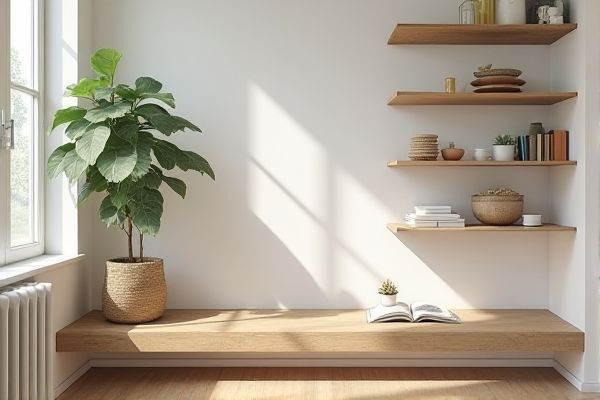
Shelf liners protect your shelves from scratches, spills, and stains while providing a non-slip surface to keep items secure, unlike bare shelves that are more prone to damage and harder to clean. Discover how choosing the right option can enhance your storage and extend the life of your shelves by reading the rest of the article.
Table of Comparison
| Feature | Shelf Liner | Bare Shelf |
|---|---|---|
| Protection | Prevents scratches, stains, and moisture damage | No protection; prone to scratches and stains |
| Cleaning | Easy to clean; removable and washable | Requires frequent cleaning; can be harder to maintain |
| Slip Resistance | Provides grip to prevent items from sliding | No slip resistance; items may shift |
| Appearance | Available in various colors and patterns for decoration | Natural wood or material look; minimalist |
| Installation | Simple, peel-and-stick or cut-to-fit | No installation required |
| Durability | Can wear out over time; replaceable | Long-lasting if maintained |
| Cost | Low to moderate | No additional cost |
Introduction to Shelf Liners and Bare Shelves
Shelf liners provide a protective layer that prevents scratches, stains, and moisture damage on shelves, enhancing cleanliness and longevity. Bare shelves offer a simple, natural surface that is easy to clean but can be more susceptible to wear and damage from spills or heavy items. Choosing shelf liners improves grip and aesthetics, while bare shelves maintain a minimalist look and require less maintenance upfront.
Key Differences: Shelf Liner vs. Bare Shelf
Shelf liners provide a protective barrier that prevents scratches, stains, and moisture damage, whereas bare shelves are exposed to wear and tear, leading to potential surface deterioration. Shelf liners offer enhanced grip and cushioning for items, reducing slippage and breakage compared to the smooth, exposed surface of bare shelves. Additionally, shelf liners are easier to clean and replace, improving hygiene and maintenance efficiency over bare shelves.
Pros of Using Shelf Liners
Shelf liners protect your shelves from scratches, stains, and moisture, extending their lifespan and maintaining cleanliness. They provide a non-slip surface, preventing items from shifting or falling, which enhances organization and safety. Using shelf liners also makes cleaning easier, as they can be removed and washed, keeping your storage spaces hygienic and fresh.
Cons of Using Shelf Liners
Shelf liners can trap moisture, leading to mold and mildew growth that damages stored items and shelves themselves. They may peel or curl over time, creating an untidy appearance and requiring frequent replacement. Some liners also contain chemicals or adhesives that can emit odors or react with certain foods and materials.
Benefits of Bare Shelves
Bare shelves offer superior airflow, reducing moisture buildup and preventing mold or mildew growth, which is ideal for storing food items. They are easier to clean and maintain, as there are no liners to replace or clean regularly. The natural surface also avoids trapping dirt and grime, promoting a healthier and more hygienic storage environment.
Drawbacks of Bare Shelves
Bare shelves often accumulate dust, dirt, and grease more quickly, leading to frequent cleaning and potential damage to the surface. Without protection, your items might slip or scratch the shelf, reducing both safety and shelf lifespan. Moisture and spills can penetrate the shelf material, causing warping or stains that are harder to remove compared to a lined surface.
Material and Style Options for Shelf Liners
Shelf liners offer diverse material options including vinyl, fabric, bamboo, and cushioned foam, each providing unique durability and aesthetic appeal compared to bare shelves. Styles range from solid colors and patterns to textured or transparent finishes, allowing you to customize the look while protecting surfaces from scratches and spills. Choosing the right shelf liner enhances both the functionality and visual appeal of your storage spaces.
Cleaning and Maintenance Comparison
Shelf liners provide a protective barrier that simplifies cleaning by preventing spills and crumbs from directly contacting the shelf surface, making it easier to wipe away debris. Bare shelves often accumulate dust and stains more quickly, requiring more frequent and intensive cleaning efforts to maintain hygiene. Choosing liners can reduce maintenance time and protect your shelves from scratches, mold, or discoloration.
Cost Analysis: Shelf Liner Versus Bare Shelf
Shelf liners typically cost between $10 and $30 per roll, offering an affordable way to protect shelves from scratches, spills, and stains, whereas bare shelves incur no initial cost but may require frequent cleaning or repairs over time. Investing in shelf liners can save money by reducing wear and tear, extending the lifespan of your cabinetry and minimizing maintenance expenses. For your budget-conscious home organization, choosing shelf liners provides a cost-effective balance between protection and longevity.
Which Option is Best for Your Needs?
Choosing between shelf liner and a bare shelf depends on Your specific needs for protection, cleanliness, and aesthetics. Shelf liners offer a protective barrier against spills, scratches, and moisture, making them ideal for kitchens and areas prone to mess. Bare shelves provide a minimalist look and easy access but may require more frequent cleaning and can be prone to damage over time.
 homyna.com
homyna.com